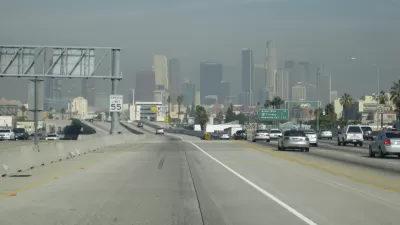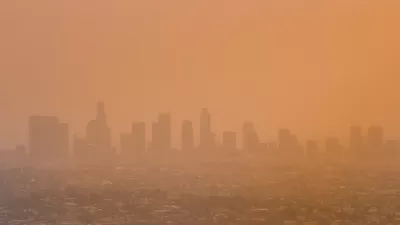A new study by NOAA scientists and colleagues shows a stunning reduction in vehicle-related air pollutants in the Los Angeles basin over the past several decades. Despite the gains, unhealthy air remains.
The recent paper, published in the Journal of Geophysical Research, shows a dramatic 98 percent drop in air pollution from motor vehicles since the 1960s, despite a threefold increase in the use of gasoline and diesel fuel over the same period. The chemicals tracked by the researchers, called volatile organic compounds (VOCs), are primarily emitted from the tailpipes of vehicles, and "are a key
ingredient in the formation of ground-level ozone," writes the National Oceanic and Atmospheric Administration.
"The magnitude of the drop in VOC levels was surprising, even to
researchers who expected some kind of decrease resulting from
California's longtime efforts to control vehicle pollution."
"Even on the most polluted day during a research mission in
2010, we measured half the VOCs we had seen just eight years earlier," said Carsten Warneke, Ph.D., a NOAA-funded scientist with the Cooperative Institute for Research in Environmental Sciences (CIRES) at the University of Colorado Boulder. "The difference was amazing."
Despite the improvements in vehicle emissions, attributed to "requirements for catalytic converters, use of reformulated fuels less
prone to evaporate, and improved engine efficiency of new vehicles," overall ozone levels in L.A. have not fallen as steeply. "Ozone pollution in the
Los Angeles Basin has decreased since the 1960s, but levels still don't
meet ozone standards set by the Environmental Protection Agency."
FULL STORY: NOAA, partners find 50-year decline in some Los Angeles vehicle-related pollutants

Study: Maui’s Plan to Convert Vacation Rentals to Long-Term Housing Could Cause Nearly $1 Billion Economic Loss
The plan would reduce visitor accommodation by 25,% resulting in 1,900 jobs lost.

Alabama: Trump Terminates Settlements for Black Communities Harmed By Raw Sewage
Trump deemed the landmark civil rights agreement “illegal DEI and environmental justice policy.”

North Texas Transit Leaders Tout Benefits of TOD for Growing Region
At a summit focused on transit-oriented development, policymakers discussed how North Texas’ expanded light rail system can serve as a tool for economic growth.

Paris Bike Boom Leads to Steep Drop in Air Pollution
The French city’s air quality has improved dramatically in the past 20 years, coinciding with a growth in cycling.

Why Housing Costs More to Build in California Than in Texas
Hard costs like labor and materials combined with ‘soft’ costs such as permitting make building in the San Francisco Bay Area almost three times as costly as in Texas cities.

San Diego County Sees a Rise in Urban Coyotes
San Diego County experiences a rise in urban coyotes, as sightings become prevalent throughout its urban neighbourhoods and surrounding areas.
Urban Design for Planners 1: Software Tools
This six-course series explores essential urban design concepts using open source software and equips planners with the tools they need to participate fully in the urban design process.
Planning for Universal Design
Learn the tools for implementing Universal Design in planning regulations.
Smith Gee Studio
Alamo Area Metropolitan Planning Organization
City of Santa Clarita
Institute for Housing and Urban Development Studies (IHS)
City of Grandview
Harvard GSD Executive Education
Toledo-Lucas County Plan Commissions
Salt Lake City
NYU Wagner Graduate School of Public Service




























